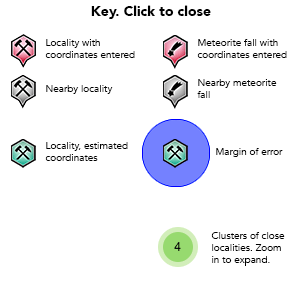Rotowaro Mine, Rotowaro, Waikato District, Waikato Region, North Island, New Zealand

| Latitude & Longitude (WGS84): | 37° 36' 45'' South , 175° 4' 35'' East |
|---|---|
| Latitude & Longitude (decimal): | -37.61275,175.07656 |
| GeoHash: | G#: rck6pbycg |
| Köppen climate type: | Cfb : Temperate oceanic climate |
Coal mine. The open pit mine is 10 kilometres south-west of Huntly.
The surface contains the Tauranga Group gravels, sands, clays; then beneath this the Pukemiro sandstone 1-11 metres thick; Glen Afton claystone 5-18 metres; the Renown and Kupakupa coal seams 19-48 metres; Taupiri coal seam 0-25 metres; and the basement Murihiku Terrane.
The coal is sub-bituminous A. Fireclay encases the seams, mainly consisting of kaolinite, with minor quartz and illite. A layer of siderite nodules may occur immediately above the coal seams.
(Masalehdani, 2007) is a study of near surface to surface porcellainites in various colours, the species mentioned mostly not apparent in hand specimens apart from iron oxides.
The mine was opened by the New Zealand government controlled State Coal in 1978, whose name later changed to Solid Energy. Overburden from the open pit mine is dumped into old pits called Township, Waipuna, and Awaroa, which are rapidly disappearing, and will be rehabilitated into pasture or pine plantations.
In later decades Solid Energy contracted out the mining operations, however this did not always work to plan. HWE gained the contract to work the mine in 1998. Contractor HWE and Solid Energy were in court in 2005, with Solid Energy trying to stop HWE withdrawing equipment and staff, worried it would not meet coal supplies Solid Energy had agreed to sell its customers, namely Glenbrook Steel and the Huntly power station. HWE in turn stated it had not been supplied a schedule by Solid Energy and it was costing them money to have staff and equipment idle for periods. This argument continued for a number of years, especially after HWE went into liquidation. Theiss then took over contract mining, and Stevenson Mining from 2011.
Solid Energy was liquidated in 2015, after going into debt exploring creative ways to use coal. Bathurst Resources/Talleys Energy joint venture took over the mine in 2017. The mine produces 1.5-1.9 Mt of coal per annum.
Mineral List
6 valid minerals.
Rock Types Recorded
Select Rock List Type
Alphabetical List Tree DiagramRegional Geology
This geological map and associated information on rock units at or nearby to the coordinates given for this locality is based on relatively small scale geological maps provided by various national Geological Surveys. This does not necessarily represent the complete geology at this locality but it gives a background for the region in which it is found.
Click on geological units on the map for more information. Click here to view full-screen map on Macrostrat.org
| Rupelian 28.1 - 33.9 Ma ID: 1346314 | Mangakotuku Formation of Lower Te Kuiti Subgroup (Te Kuiti Group) Age: Oligocene (28.1 - 33.9 Ma) Stratigraphic Name: Mangakotuku Formation Description: Massive siltstone and mudstone, with glauconitic, muddy sandstone beds; common siderite concretions near base. Comments: Paleogene sedimentary rocks Lithology: Major:: {siltstone},Minor:: {mudstone, claystone, sandstone, greensand} Reference: Heron, D.W. . Geology Map of New Zealand 1:250 000. GNS Science Geological Map 1. [13] |
| Late Eocene - Middle Eocene 33.9 - 47.8 Ma ID: 1313349 | Te Kuiti Group Eocene sedimentary rocks Age: Eocene (33.9 - 47.8 Ma) Stratigraphic Name: Te Kuiti Group Description: Calcareous mudstone and glauconitic sandstone with minor conglomerate in Northland. Local carbonaceous mudstone and minor sandstone and conglomerate with carbonaceous shale and coal seams in Northland, Auckland and north Waikato. Comments: Zealandia Megasequence Mainly Marine Sedimentary Rocks (Paleogene to Cretaceous) Lithology: Mudstone, sandstone, conglomerate, shale, coal Reference: Edbrooke, S.W., Heron, D.W., Forsyth, P.J., Jongens, R. (compilers). Geology Map of New Zealand 1:1 000 000. GNS Science Geological Map 2. [12] |
| Jurassic 145 - 201.3 Ma ID: 3188091 | Mesozoic sedimentary rocks Age: Jurassic (145 - 201.3 Ma) Lithology: Tuffaceous sandstone,argillite,conglomerate,greywacke,siltstone,sandstone Reference: Chorlton, L.B. Generalized geology of the world: bedrock domains and major faults in GIS format: a small-scale world geology map with an extended geological attribute database. doi: 10.4095/223767. Geological Survey of Canada, Open File 5529. [154] |
Data and map coding provided by Macrostrat.org, used under Creative Commons Attribution 4.0 License
References
External Links
https://www.sourcewatch.org/index.php/Rotowaro_Opencast_Mine
http://mininglink.com.au/site/rotowaro
https://www.cimic.com.au/our-business/projects/completed-projects/rotowaro-coal-mine
http://bathurst.co.nz/our-operations/rotowaro
http://stevenson.co.nz/rotowaro-coal-mine/rotowaro



